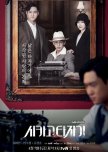No matter which era you live in, life is an agony. There’s no such thing as perfect world. Every era has its own problems and things you’d want to resist. We resist, struggle, fight, and win. That’s how we shape the world we live in. Thanks to the youth you guys sacrificed, we can live in a world like this now. Pass this message along to the youth of the time: You fought hard. And I thank them for creating this world for us. (Han Se Joo – Chicago Typewriters)
Doesn’t Han Se Joo’s speech sound like one of Yoo Ah In’s statements in his SNS? I would buy it if they said he was the one who wrote these particular lines. I’m sure this is yet another reason why he picked Chicago Typewriter for his final project before enlistment.
As the story goes towards the end and each character tries to recall their past life, Chicago Typewriter‘s 1930s scenes take center in most part of the episodes. The 1930s classic story of the struggle of young independence fighters is done perfectly. There’s a hinge of sorrow and joy, there’s a hint of hope and desperation. And there’s Carpe Diem– seize the day. The scenes make a lot of viewers curious and digging more into the history of Korean independence as well.
Doesn’t Han Se Joo’s speech sound like one of Yoo Ah In’s statements in his SNS? I would buy it if they said he was the one who wrote these particular lines. I’m sure this is yet another reason why he picked Chicago Typewriter for his final project before enlistment.
As the story goes towards the end and each character tries to recall their past life, Chicago Typewriter‘s 1930s scenes take center in most part of the episodes. The 1930s classic story of the struggle of young independence fighters is done perfectly. There’s a hinge of sorrow and joy, there’s a hint of hope and desperation. And there’s Carpe Diem– seize the day. The scenes make a lot of viewers curious and digging more into the history of Korean independence as well.
Esta resenha foi útil para você?
























